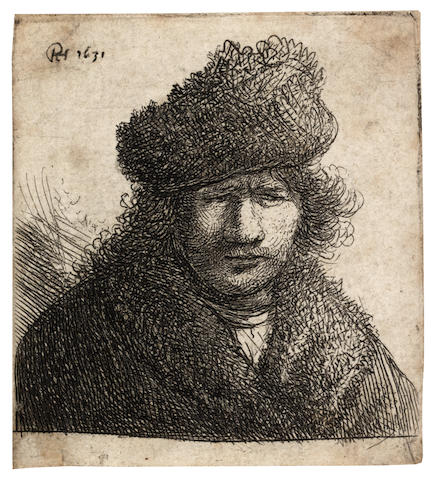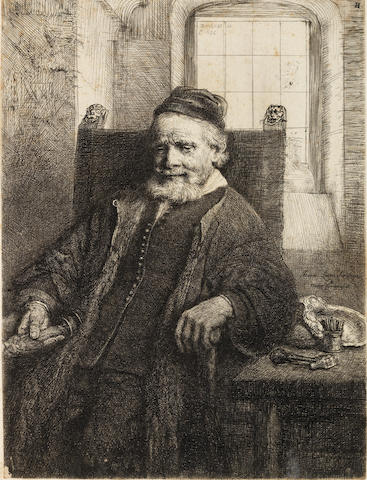
Rembrandt Harmensz van Rijn (Dutch, 1606-1669)
Studies of the head of Saskia and others
(Bartsch 365; New Hollstein 157)
Etching, 1636, a fine early impression of New Hollstein's first state of two, with fine zig-zag lines on the forehead of the woman lower centre and numerous fine wiping scratches, on laid, with thread margins, 151 x 126mm (5 7/8 x 4 7/8in)

Rembrandt Harmensz van Rijn (Dutch, 1606-1669)
Self Portrait in a slant fur cap: Bust
(Bartsch 14; New Hollstein 97)
Etching and engraving, circa 1631, a good impression of New Hollstein's fifth state of seven, with additional diagonal shading to the upper lip and the forehead, on laid, trimmed to or along the platemark, 62 x 56mm (2 3/8 x 2 1/4in

Rembrandt Harmensz van Rijn (Dutch, 1606-1669)
Self Portrait with plumed cap and lowered sabre
(Bartsch 23; New Hollstein 135)
Etching and engraving, 1634, a fine impression of the final third state, after the plate has been reduced to a regular oval, on laid, with a Foolscap watermark, trimmed to the platemark, 130 x 108mm (5 1/8 x 4 1/4in)
The sabre of the title only appears in the rare first state where the plate is rectangular and shows Rembrandt in a three-quarter length pose. In the second and third it has been reduced to an oval, concentrating the viewer's attention on the artist.

Rembrandt Harmensz van Rijn (Dutch, 1606-1669)
Self Portrait with Saskia
(Bartsch 19; New Hollstein 158)
Etching, 1636, New Hollstein's third state of four, with a small area of false biting next to his collar on the right, on laid with narrow margins, with a DG countermark, 104 x 95mm (4 1/8 x 3 3/4in

Rembrandt Harmensz van Rijn (Dutch, 1606-1669)
Self Portrait in a cap and scarf with the face dark: Bust
(Bartsch 17; New Hollstein 120)
Etching, 1633, a fine impression of New Hollstein's second state of five, with the signature and date added, shading added to the sleeve and breast and the moustache extended over the contour of the right cheek, with plate tone and delicate wiping scratches, on laid, with narrow margins, 132 x 103mm (5 1/8 x 4in)
Rembrandt portrays himself in military dress with laces on his shoulder for attaching armour. With his face in deep shadow, it is the thoughtful, reserved pose of a young man. This experimentation with chiaroscuro shows the influence of the Italian masters, such as Caravaggio. Rembrandt collected Italian prints and was able to study the Italian paintings which were being imported into Amsterdam at this time by dealers like Hendrick van Uylenburgh, with whom Rembrandt had lodged on his arrival in the city. This impression is printed with considerable tone in the background and has the delicate wiping scratches and well-inked platemark that indicate an early impression.

Rembrandt Harmensz van Rijn (Dutch, 1606-1669)
Self Portrait Leaning on a Stone Sill
(Bartsch 21; New Hollstein 171)
Etching with touches of drypoint, 1639, a fine impression of the second final state, with the cap band extended towards the right and the right cap edge clearly defined, on laid, with narrow margins, with a countermark possibly 'PDB', 205 x 164mm (8 1/8 x 6 1/2in)
Taking two sixteenth-century portraits as his sources, Titian's Portait of a Man with a Quilted Sleeve (known as Ariosto) and Raphael's Portrait of Baldassare Castiglione, Rembrandt portrayed himself as a gentleman and a master of his art, putting himself on a par with these two great Renaissance artists.

Rembrandt Harmensz van Rijn (Dutch, 1606-1669)
Self portrait, etching at a window
(Bartsch 22; New Hollstein 240)
Etching and drypoint, 1648, a very good impression of New Hollstein's seventh state of nine, with the right cheek redefined, the shadows reworked partly with a mezzotint rocker and additional lines in the upper left corner and on his right hand, on laid, with narrow margins, 160 x 130mm (6 1/4 x 5 1/8in)
Finely etched lines were employed to model the face and drypoint and burin were then used to define the body, desk and books. This later reworking of the shaded areas served to recall the tonal contrast of the earlier impressions.

Rembrandt Harmensz van Rijn (Dutch, 1606-1669)
The Card player
(Bartsch 136; New Hollstein 193)
Etching, 1641, a good impression of New Hollstein's first state of five, with an irregular strip of unworked plate along the upper margin and with an accidental scratch across his left cheekbone and in his hair to the right, on laid, with thread margins, 88 x 82mm (3 7/8 x 3 1/4in)

Rembrandt Harmensz van Rijn (Dutch, 1606-1669)
A Man at a Desk wearing a Cross and Chain
(Bartsch 261; New Hollstein 194)
Etching, 1641, a fine impression of New Hollstein's fourth state of five, with the contours of the book which protruded over the image edge burnished away, details in the hair and face strengthened in drypoint and new shading in the background, with burr on the left sleeve, on thick laid, with narrow margins, 154 x 102mm (6 1/8 x 4in)

Rembrandt Harmensz van Rijn (Dutch, 1606-1669)
Menasseh Ben Israel
(Bartsch 269; New Hollstein 156)
Etching, 1636, a good impression of New Hollstein's second state of five, with the indent in the left cheek straightened and shading added in several areas including the right earlobe, the outermost fold of his cloak on the left and inside the hat just to the right of his left cheek, on laid, with narrow margins, 149 x 103mm (5 7/8 x 4 1/8in
Menasseh Ben Israel was a rabbi, author and printer, who established the first Hebrew printing press in the Netherlands in 1626 and played an important role in the re-establishment of the Jewish community in England in 1656, having petitioned Oliver Cromwell to this effect. He was a highly regarded scholar and preacher and Rembrandt presents him in a bust length portrait with direct gaze, encouraging the viewer to engage with the character.

Rembrandt Harmensz van Rijn (Dutch, 1606-1669)
Cornelis Claesz. Anslo, Preacher
(Bartsch 271; New Hollstein 197)
Etching and drypoint, 1641, New Hollstein's third state of five, with reworking around the right eye and the fur lining of the cloak to the right of the book, fine lines added to his left sleeve and his chest below the pen, on thick laid, with thread margins, 188 x 158mm (7 3/8 x 6 1/4in)

Rembrandt Harmensz van Rijn (Dutch, 1606-1669)
The Great Jewish Bride
(Bartsch 340; New Hollstein 154)
Etching with drypoint, 1635, a fine impression of the final fifth state, with the horizontal lines to indicate the stonework in the right background and additional shading on the wall behind her head, on laid, with a partial watermark of a double-headed eagle, trimmed to the platemark, 220 x 168mm (8 3/4 x 6 3/4in)

Rembrandt Harmensz van Rijn (Dutch, 1606-1669)
Old man with a divided fur cap
(Bartsch 265; New Hollstein 182)
Etching and drypoint, 1640, a good impression of New Hollstein's first state of two, with the slipped stroke next to his left eye running from the cap edge to his left cheek, with burr on the cape at the right, on japan laid, with a partial Arms of Amsterdam watermark, trimmed to platemark, 150 x 139mm (5 7/8 x 5 1/2in)

Rembrandt Harmensz van Rijn (Dutch, 1606-1669)
Jean Lutma, Goldsmith
(Bartsch 276; New Hollstein 293)
Etching, engraving and drypoint, 1656, New Hollstein's third state of four, with the window and before the cross-hatching in the upper right side of the window border, the upper right area of the chair and around the hammer, on laid, trimmed along or just inside the platemark, 196 x 149mm (7 3/4 x 5 7/8in)
Acknowledgment: Bonhams



No comments:
Post a Comment